Reptile and amphibian exclusion fencing
Overview of proven design and installation techniques for reptile and amphibian exclusion fencing.
The purpose of this guidance document is to provide an overview of proven design and installation techniques for reptile and amphibian exclusion fencing. Though this document points to site and species-specific design requirements, it is important to recognize that every situation is different. This guidance is not meant to replace site-specific advice obtained from local MNR staff or experienced exclusion fencing contractors. Moreover, exclusion fences are only effective when well planned, properly constructed, and maintained.
Exclusion fencing seeks to eliminate access to specific areas where activities that could harm animals are occurring (e.g. active aggregate operations, construction sites, and roads). The selection and installation of exclusion fencing can present some challenges, particularly if multiple species are being excluded. For example, some reptiles and amphibians are able to dig under fencing while others can climb over. Some may also take advantage of burrows dug by other animals. To maintain effectiveness, the bottom of the fence should be buried or secured firmly to the ground and minimum height recommendations (Table 1) are considered.
Exclusion fence design should consider the target species as well as those that might be unintentionally impacted. Fencing material should not pose a risk of entanglement or permit individuals to pass underneath or between openings. Landscape features such as topography and substrate need to be considered as they may constrain fencing design.
Including plans for fencing in advance of a project can increase efficiency and fence effectiveness. For example, long-term road projects that will include a permanent sound barrier could design the sound barrier such that it also meets the specifications of the required exclusion fence.
Effective fence characteristics
The fence burial and height recommendations listed in Table 1 below have been compiled from scientific literature, established management practices, and practitioner best advice. These are general recommendations and at times other specifications may be more appropriate. For instance, in areas where the substrate does not permit fence burial, weighing down the fence with heavy items (e.g. sand bags) or backfilling may be acceptable. Where needed, speak with your local MNR staff or experienced exclusion fencing contractor to develop site-specific plans.
If multiple species are being excluded from the same area, and the species-specific fencing specifications differ, the uppermost minimum height and greatest depth recommendation should be used (Table 1). If you are excluding both Blanding’s Turtle and Gray Ratsnake, for example, the exclusion fence should be a minimum of 2 m tall (see Gray Ratsnake section below for additional details).
Exclusion fences should be installed prior to emergence from hibernation. A survey of the enclosed/secluded area should be conducted immediately following fence installation to ensure that no individuals have been trapped on the wrong side of the fence.
| Species | Recommended depth of fence buried (cm) |
Recommended height of fence |
|---|---|---|
| Turtles - general | 10 - 20 | 60 |
| Eastern Musk Turtle, Wood Turtle | 10 - 20 | 50 |
| Massasauga, Eastern Hog-nosed Snake, Butler’s Gartersnake, Queensnake | 10 - 20 | 60 |
| Gray Ratsnake & Eastern Foxsnake | 10 - 20 | 200 |
| Fowler's Toad | 10 - 20 | 50 |
| Snakes - general | 10 - 20 | 100 |
| Common Five-lined Skink | 10 - 20 | unknown |
| Salamanders | 10 - 20 | 30 |
Duration of activities and degree of anticipated disturbance
The type of disturbance, the proximity to disturbance, and the planned fence longevity are factors that influence which type of exclusion fence is most effective. For short-term activities (i.e. 1 to 6 months) such as minor road repairs, a light-duty geotextile fence is appropriate. Longer term or permanent fencing projects, however, require more durable materials such as – heavy-duty geotextile, wood, concrete, woven-wire, sheet metal, vinyl panels, or galvanized mesh.
Geotextile fences
Geotextile fences (e.g. silt fences) come in many types and qualities. They can be very effective for the temporary exclusion of reptiles and amphibians. For the purposes of this document, temporary use ranges from a few months up to 2-3 years. Winter weather is generally damaging to geotextile materials and the cost of maintenance over the long-term should be considered during the planning phase. Depending upon the quality, geotextile can be resistant to UV degradation and the bio-chemical soil environment.
Light-duty geotextile fencing
Light-duty geotextile fencing is made of nylon material and is typically purchased with wooden stakes pre-attached at 2 m to 3 m intervals (Figure 1). It can also come without pre-attached stakes. Light-duty geotextiles are largely intended for projects with shorter durations of only a few months in duration and up to one season.
Geotextile fencing with nylon mesh lining should be avoided due to the risk of entanglement by snakes.
To use light-duty geotextile fencing:
- Fencing fabric is effective if attached to wooden, heavy plastic or metal stakes using heavy-duty wire staples or tie-wire (Figure 10).
- Secure the fence on posts that are placed at 2 m to 3 m apart. If using the greater recommended distance between posts, additional maintenance may be required to maintain effectiveness.
- Securely drive the stakes into the ground to a recommended depth of 30 cm. The fencing fabric should be buried to the recommended specifications in Table 1 and back-filled with soil.
- For snakes, supporting posts should be staked on the activity side (e.g. on the side facing the aggregate stock pile or the road - Figure 10).
- Light-duty geotextile fences are not effective where rocks or other hard surfaces prevent proper anchoring of fence posts and burial of the fence fabric.
- Light-duty geotextile fences are not effective where a large amount of concentrated run-off is likely or to cross streams, ditches or waterways without specific modifications.
- Contact your local MNR staff or experienced exclusion fencing contractor for advice and recommendations.
- See general best practices section below for additional details.
Generally, light-duty geotextile fences are not effective if they exceed 1 metre in height unless purposely manufactured for greater height (e.g. stakes placed at closer intervals or cross braces). If greater height is required consider using heavy duty geotextile, hardware cloth or other fencing materials.

Heavy-duty geotextile fencing
Heavy-duty geotextile fencing is typically constructed of a thick felt-like fabric. It may also be called ‘double row’ or ‘trenched’ fencing. For support, this fencing uses a woven wire fence (e.g. chain link) or some other structure (Figure 2). It is recommended that a minimum density of 270R or equivalent woven geotextile fabric is used.
Heavy-duty geotextile material can be effective for up to 2 or 3 years with proper maintenance. This type of fencing can be damaged by small mammals chewing through or torn by heavy debris (e.g. tree branches). Therefore, it may be best suited to turtles, which are less likely to take advantage of holes or tears in the fabric. If used to exclude snakes or other animals, more maintenance may be required.
- The wire fence should be installed on the activity side to prevent animals from leveraging and climbing into the exclusion area while allowing the animal to escape if they find themselves on the wrong side (Figure 10).
- Geotextile fences across streams, ditches or waterways should have case-specific modifications.
- Contact your local MNR staff or experienced exclusion fencing contractor for advice.
- See light-duty geotextile section above and general best practices below for additional details.
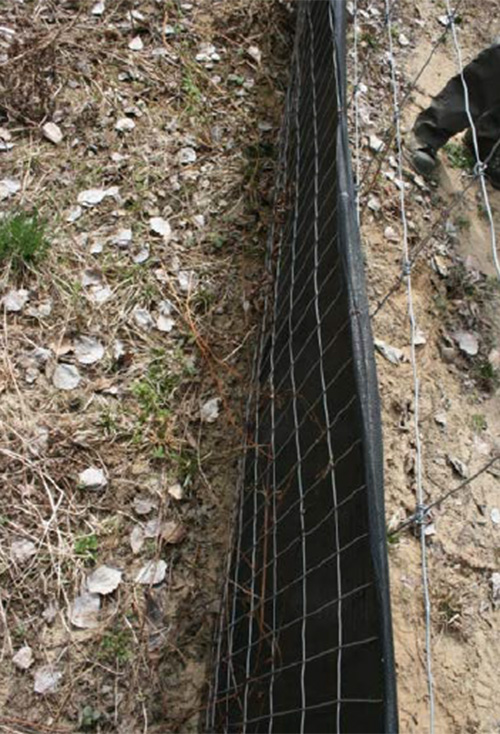
Hardware cloth fences
Hardware cloth (also known as galvanized mesh or Birdscreen) is durable, cost effective and useful for excluding reptiles and amphibians. The fence should be made of heavy galvanized hardware cloth with a 1/4 inch mesh. For fences intended to exclude small snakes, a 1/8 inch mesh may be more effective. In contrast, fencing intended to exclude turtle species can have a larger mesh size (e.g. 1/2 inch). Larger mesh may have a longer lifespan as it is constructed from a thicker material compared to smaller mesh sizes.
To use hardware cloth fencing:
- Secure the fence on posts placed a recommended 2.5 m apart with the stakes on the activity side (Figure 10).
- Pull the mesh taut and staple or secure with screws and a metal stripping to prevent the mesh from being ripped when pressure is applied.
- Installing a top rail or folding the mesh over a taut smooth wire reduces tearing (Figures 3 and 4).
- An outward facing lip installed on the species side ensures that snakes and amphibians are unable to climb or jump over the fence (Figure 4; Figure 10)
- Tears can be mended with 18-gauge galvanized wire.
- See general best practices section below for additional details.
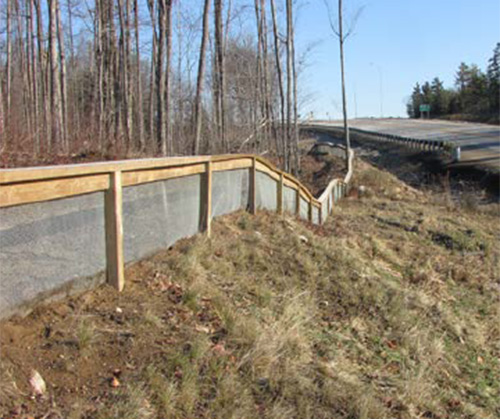
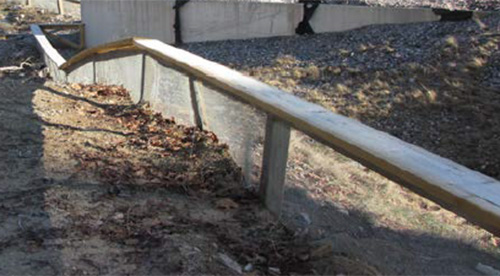
Wood lath snow fencing
In certain circumstances, wood lath snow fencing can be effective at excluding turtles. This fencing is typically constructed from soft wood slats that have been woven together with 13-gauge wire and is then attached to steel fence posts which have been driven into the ground.
Wood lath fencing is cost effective and can easily be laid down during the winter to prevent damage. The durability of the material, however, is not meant for very long-term use (e.g. more than 3 years), unless regular maintenance occurs.
To use wood lath snow fencing:
- The fencing should be attached to heavy plastic or metal stakes using heavy-duty wire staples or tie-wire.
- The stakes are recommended to be placed at 2 to 3 m intervals and securely driven into the ground 30 cm or more.
- Wood lath snow fencing across streams, ditches or waterways should have case-specific modifications.
- Wood lath snow fencing lends itself well to being combined with other types of material to ensure complete exclusion.
- See general best practices section below for additional details.

Exclusion fencing for Gray Ratsnake and Eastern Foxsnake
Gray Ratsnake and Eastern Foxsnake are the largest snakes in Ontario - reaching nearly 2 m in length. They are also excellent climbers. For this reason, fencing intended to exclude either of these species has additional recommended design specifications.
- The fence should be at least 2 m high.
- The material on the species side (Figure 10) should be smooth to prevent the snakes from climbing into the excluded area.
- Stakes should be on the activity side of the fence (Figure 10).
- Due to the increase in fence height, it is valuable to decrease the distance between posts or install diagonal braces.
- See general best practices section below for additional details.
Concrete, sheet metal and vinyl walls
Concrete, metal or vinyl walls can stand alone or be combined with woven wire or chain link fences. They are durable, require minimal maintenance and are effective in excluding target species from high risk areas and guiding them to crossing structures or other desired locations (Figures 6 and 7). This fence type is comprised of a continuous vertical face of concrete, metal or vinyl sheeting with no gaps. Concrete walls can be installed as either pre-cast sections or pour directly in place.
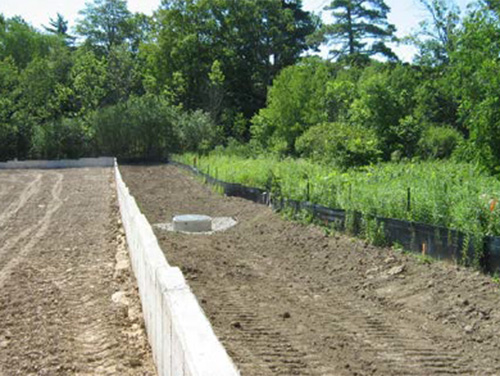

The wall height depends upon the target species, but they are usually between 45 and 60 cm tall and buried 25 cm. Concrete, metal or vinyl exclusion fencing is most appropriate for salamanders, skinks, small snakes, and small turtles. For large turtle species, a chain link fence can be installed directly on top of the concrete wall for complete exclusion.
Habitat connectivity
Habitat connectivity is the connectedness between patches of suitable habitat or the degree to which the landscape facilitates animal movement. Exclusion fencing installed along roads or other large projects can effectively reduce or eliminate habitat connectivity for animals. In these scenarios, exclusion fencing should be considered with eco-passages in order to maintain connectivity. Fencing in isolation should be viewed as a temporary method to reduce mortality until species movement can be restored. Where eco-passages are not feasible they should be identified for consideration with any future road work or development to improve connectivity.
During the installation of fencing with an eco-passage, it is important that the fencing sits flush with the passage to ensure that there are no gaps where animals can squeeze through.
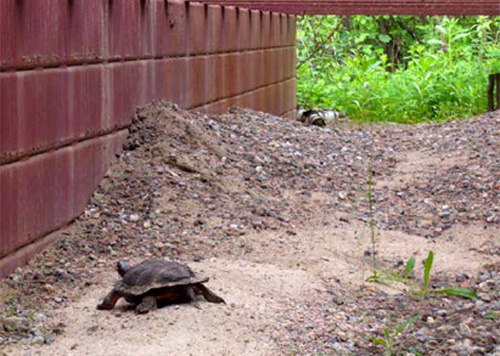
General best practices
- To deter digging, bury the fence 10 cm down with an additional 10 cm horizontal lip (Figure 10).
- Backfill and compact soil along the entire length on both sides of the fence (Figure 10).
- Once the fence is installed, a survey should be done to ensure that no individuals have been trapped inside (speak with MNR for survey advice).
- Exclusion fencing intended to exclude snakes should have the stakes installed on the activity side (opposite the normal requirement for sediment control fencing) to prevent snakes from using the stakes to maneuver over the fencing.
- For snakes and toads, the fence should have an overhanging lip on the species side (Figure 10).
- Fences should be inspected after spring thaw and at regular intervals throughout the active season, especially following heavy rain events. This is particularly important for geotextile fences. Any damage that affects the integrity of the fence (e.g. tears, loose edges, collapses, etc.) should be fixed promptly.
- Tall or woody vegetation on the species side of the fence should be managed if there is a risk that it may enable the animals to climb over. This is most important during spring and fall. Proceed cautiously to not harm animals protected plant species during vegetation removal.
- When installing an eco-passage, fencing or exclusion walls should be used as a guiding system to direct animals to passage openings.
- Natural screens such as trees or shrubs can help to reduce road access and can be combined with fencing to provide protection of individuals from predation.
- Install fences with a turn-around at the ends furthest from the wetland habitat and at any access areas to assist in redirecting animals away from any fence openings (Figure 9).
- Curving the ends of the fencing inward (i.e. away from the road or construction site) may help to reduce access to these locations. The ends may also be tied off to natural features on the landscape such as trees or rock cuts.

Water movement and drainage
- In areas where surface water run-off may erode a soil-based backfill, consider using rocks or sand bags. Ensure these materials cannot be used by animals to climb over the fence.
- Where possible, minimize the number of water crossings: when necessary, it should occur where flow is minimal.
- Fence posts in waterways or areas prone to seasonal flooding should be driven rather than dug – unless following established best practices.
- Fencing should be placed above the high water mark anticipated for high water events such as spring freshet or periods of heavy or continuous rainfall.
Topography
- Fence posts should be closer together in undulating topography.
- Fences installed on slopes have a different effective height depending upon whether the animal will be approaching from the up or down slope. The fence height can be adjusted accordingly.
Improvements or questions regarding exclusion fencing can be brought to the local MNR Species at Risk Biologist or other MNR staff.
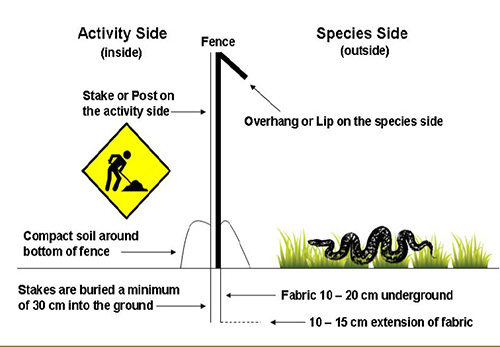
Resources
The reptile and amphibian exclusion fencing best practices is available in PDF format upon request. Please email PDF requests to ESAReg@ontario.ca.
- ACO Systems Ltd., 2007. Wildlife fencing systems. Accessed July 2012.
- Dodd, C.K, W.J. Barichivich, and L.L. Smith. 2004. Effectiveness of a barrier wall and culverts in reducing wildlife mortality on a heavily traveled highway in Florida. Biological Conservation 118: 619-631.
- Flat-tailed Horned Lizard Interagency Coordinating Committee. 2003. Flat-tailed horned lizard rangewide management strategy, 2003 revision. 80 pp., plus appendices.
- Jochimsen, Denim M., Charles R. Peterson, Kimberly M. Andrews, and J. Whitfield Gibbons. 2004. A literature review of the effects of roads on amphibians and reptiles and the measures used to minimize those effects. USDA Forest Service.
- KRCA, 2006. Silt Fence Installation and Maintenance. KRCA, Kawartha Region Conservation Authority Environmental Advisory Services, Port Hope, ON, 2 pp.
- Long, K, and A. Robley, 2004. Cost Effective Feral Animal Exclusion Fencing for Areas of High Conservation Value in Australia. The Department of Environment and Heritage. Natural Heritage Trust, Victoria, Australia, 61 pp.
- Queensland Department of Transport and Roads, 2010. Fauna Sensitive Road Design Manual, Volume 2: Preferred Practices. Chapter 9, Case Studies, Connecting Queensland, Road and Delivery Performance Division, Queensland Government, 134 pp.
- Sarell, M, 2006. Living in Nature Series: How to Snake-proof Your House and Yard. South Okanagan-Similkameen Stewardship Program. The Land Conservancy of BC, Penticton, BC. 8 pp.
- TWP Incorporated, Galvanzied Mesh for Snake Control. Accessed July 2012.
Footnotes
- footnote[1] Back to paragraph Does not include the 10 cm horizontal lip that should extend outward an additional 10-20 cm (see Figure 10)
- footnote[2] Back to paragraph The height of fencing has been provided as an approximate. Fencing materials may in fact not be available in proportions that would allow for these precise measurements. It is most effective, if the height and burial depth recommendations are met.